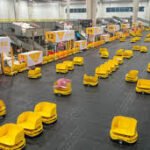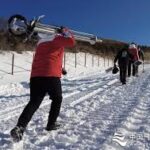At 6:30 in the morning, when the street was still quiet, more than 30 teenagers were already in training on the ice rink of an ice sports center in Jilin city, northeast China’s Jilin province.
A few years ago, Li Jianrou, short track speed skating champion at the 2014 Sochi Winter Olympics, set up an ice and snow sports club at the center to cultivate young people interested in winter sports.
“Many coaches in the club used to be professional athletes. The club provides professional gear and tailored training plan. I believe my performance will be further improved after this winter vacation,” said Ma Yutong, a 15-year-old trainee who has learned speed skating in the club for five years.
“It took me 18 years of practice to win an Olympic gold medal. Now we want to share our experience with more people,” said Li, adding that she hopes the children in her club will compete in the Winter Olympics someday.
Jilin province, which enjoys a long snowfall period and abundant snow and sees great popularity of ice and snow sports among citizens, has cultivated a good number of Winter Olympic champions, including short track speed skating Olympic champion Zhou Yang and Li Jianrou.
Local governments in the province have rolled out various policies to turn retired winter sports athletes into full-time or part-time teachers in schools. Zhou now serves as a public-welfare coach in ice and snow activities held by the province, while Shan Zhaojian, China’s first national skiing champion, compiles textbooks on ice and snow sports for children.
Besides providing professional training for children interested in winter sports, Jilin province has also endeavored to create better conditions for the participation of ordinary primary and middle school students in ice and snow sports.
In Pingquan Primary School in Nanguan district, Changchun city, capital of Jilin province, the playground is covered with a smooth layer of ice.
“When the rink in our school opens in winter, everybody is so thrilled,” said Shi Jiayu, a second grader in the school who skated with her classmates on the rink during winter vacation. The school’s tradition of ice and snow sports dates back to the 1980s.
In the past, the school didn’t have so great conditions for winter sports it enjoy today. Back then, teachers, students and their parents often needed to use lunch box, face wash basin, and even small bath basin to create ice blocks with water in winter and put them together to make an ice surface, according to Liu Zhaohui, a teacher in the school.
Physical education teachers would then pour water onto the ice surface from a basin to make the ice surface smooth, recalled Liu, adding that the whole process took about 20 days.
“Things are totally different now. We use water hose to pour water onto the rink and grind the ice surface with ice resurfacer. All the funds and equipment related to winter sports are provided by the government,” Liu said.
The changes to the ice rink of Pingquan Primary School have mirrored the endeavors of Jilin province to develop winter sports, including providing equipment for flooding ice rink, ice skate blade, and other equipment for schools with ice rink, and offering students opportunities to take classes at professional ski resorts for free.
“As of the end of 2021, Jilin had built 557 schools with ice and snow sports programs, and more than 4 million students had participated in winter sports,” said Sun Dalong, deputy director of the department of physical education, health, and art education of the education authority of Jilin province.
Riding the wave of the 2022 Olympic and Paralympic Winter Games to kick off soon in Beijing, Jilin province has also made efforts to continuously improve local venues for winter sports competitions and public-benefit ice and snow sports facilities. The province floods and builds more than 400 public-benefit ice rinks a year, facilitating the participation of all citizens in ice and snow sports activities. So far, the province has built 46 ski resorts, with the pistes covering a total area of 1,032 hectares.
Based on their respective local conditions, many cities across the province have adopted various measures to provide diversified winter sports activities for citizens.
By integrating the development of ice and snow industry into various industries, Jilin city is creating a complete industrial chain of winter sports in its pilot zone for high-quality development of ice and snow economy.
A wide variety of ice and snow sports-themed events hosted by cities in Jilin province, including the annual Vasaloppet China Changchun Jingyuetan International Ski Festival in Changchun city, snowfield marathon in Tonghua city and a series of activities held during the eighth National Public Ice and Snow Season in Yanbian Korean autonomous prefecture, enjoy great popularity in the country.
“Jilin province will host more than 300 competitions of various types during this snow season, involving over 10 million people in ice and snow sports. And we will endeavor to encourage more citizens to take part in the sports,” said an official with Jilin provincial bureau of sports.



